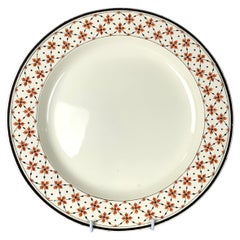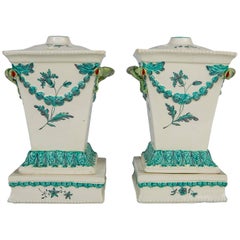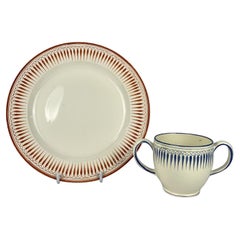Want more images or videos?
Request additional images or videos from the seller
1 of 10
Antique Creamware "King's Rose" Pattern Sugar Bowl Made circa 1780-1790
$430List Price
About the Item
- Dimensions:Height: 4.25 in (10.8 cm)Diameter: 4.25 in (10.8 cm)
- Style:Romantic (Of the Period)
- Materials and Techniques:
- Place of Origin:
- Period:
- Date of Manufacture:circa 1780-1790
- Condition:
- Seller Location:Katonah, NY
- Reference Number:1stDibs: f86651511043381613fs
About the Seller
5.0
Recognized Seller
These prestigious sellers are industry leaders and represent the highest echelon for item quality and design.
Platinum Seller
Premium sellers with a 4.7+ rating and 24-hour response times
Established in 1962
1stDibs seller since 2009
493 sales on 1stDibs
Typical response time: 1 hour
Authenticity Guarantee
In the unlikely event there’s an issue with an item’s authenticity, contact us within 1 year for a full refund. DetailsMoney-Back Guarantee
If your item is not as described, is damaged in transit, or does not arrive, contact us within 7 days for a full refund. Details24-Hour Cancellation
You have a 24-hour grace period in which to reconsider your purchase, with no questions asked.Vetted Professional Sellers
Our world-class sellers must adhere to strict standards for service and quality, maintaining the integrity of our listings.Price-Match Guarantee
If you find that a seller listed the same item for a lower price elsewhere, we�’ll match it.Trusted Global Delivery
Our best-in-class carrier network provides specialized shipping options worldwide, including custom delivery.You May Also Like
Rare Mason's Ironstone Miniature Bowl all hand painted Pattern, circa 1820
By Mason's Ironstone
Located in Lincoln, Lincolnshire
This is a rare miniature Mason's ironstone Bowl, decorated in a beautiful hand painted floral gilded pattern, which we date to circa 1820.
Miniature or toy items of Masons ironstone...
Category
Antique Early 19th Century English Chinoiserie Ceramics
Materials
Ironstone
$261
H 1.65 in W 2.85 in D 2.4 in
Mason's Ironstone Lidded Dish or Bowl in Flying Bird Pattern, circa 1890
By Mason's Ironstone
Located in Lincoln, Lincolnshire
This is a rare ironstone lidded dish or bowl in a rare shape, hand enameled in the Flying Bird pattern, made by Mason's Ironstone of Lane Delph, Staffordshire, England, during the la...
Category
Antique Late 19th Century English Chinoiserie Pottery
Materials
Ironstone
Rare Mason's Ironstone Miniature Urn in Gold Rose Japan Pattern, circa 1820
By Mason's Ironstone
Located in Lincoln, Lincolnshire
This is a rare miniature Mason's ironstone Lidded Urn or Vase in the beautiful Gold Rose Japan pattern, which we date to circa 1820.
Miniature or toy items of Masons ironstone are...
Category
Antique Early 19th Century English Chinoiserie Ceramics
Materials
Ironstone
$613
H 3.88 in W 2.4 in D 2.25 in
Early Wedgwood Neoclassical Creamware Dessert Dishes Made circa 1780
By Wedgwood
Located in Fort Lauderdale, FL
A set of four early Wedgwood creamware Neoclassical dessert dishes made circa 1780.
Sir William Hamilton’s Collection of Etruscan, Greek and Roman an...
Category
Antique Late 18th Century English Neoclassical Ceramics
Materials
Creamware
Antique Masons Ironstone Platter in Red Peony and Scrolls Pattern, Circa 1835
By Mason's Ironstone
Located in Lincoln, Lincolnshire
This Ironstone pottery Platter was made by the Mason's factory at Lane Delph, Staffordshire, England and is decorated in the Red Peony & Scrolls pattern, dating to the 19th century, ...
Category
Antique 19th Century English Chinoiserie Ceramics
Materials
Ironstone
$378
H 0.9 in W 10.5 in D 9.15 in
Wedgwood Creamware Soup Plate with German Ship Decoration.
By Josiah Wedgwood
Located in Downingtown, PA
The ship is flying the flag of the last German Emperor of the Holy Roman Empire, Francis II,
Circa 1775-1790.
The rare Wedgwood creamware plate...
Category
Antique 1780s English Georgian Pottery
Materials
Creamware, Pottery
Early Coffee Cup Blue and White Boy on a Buffalo Ptn probably Spode, circa 1790
By Josiah Spode
Located in Lincoln, Lincolnshire
This is a good, very early, rare blue and white coffee cup in the "Boy on a Buffalo" pattern, probably from the factory of Josiah Spode, stoke on Trent, Staffordshire, England, made...
Category
Antique Late 18th Century English Chinoiserie Ceramics
Materials
Earthenware
$275
H 2.5 in W 3.25 in D 2.38 in
Antique Yellow Ceramic Bowl in Chinese Style
By Bretby Ceramics
Located in St Annes, Lancashire
Super art pottery bowl in Chinese style.
Wonderful simplicity and color.
Factory mark of Bretby, England on the underside.
Free shipping
Category
Antique 1890s English Chinese Export Ceramics
Materials
Pottery
Art Pottery Bowl by Herman Kähler, Denmark, Circa 1930's
Located in Rochester, NY
Hand-painted art pottery bowl by Herman Kähler, Denmark. HAK. Circa 1930's.
Category
Mid-20th Century Danish Pottery
Materials
Ceramic, Pottery
Georgian Spode Coffee Can Ironstone Kackiemon Pattern 2117, circa 1820
By Spode
Located in Lincoln, Lincolnshire
This is a good stone China (Ironstone) coffee can made by the SPODE factory in the early 19th Century, circa 1820.
The coffee can is well potted with cylindrical shape and a loop handle with the distinctive Spode kink to it. The piece is beautifully decorated with hand painted enamels in the chinoiserie Kakiemon style, pattern number 2117.
It has the Spode Stone China blue printed...
Category
Antique Early 19th Century English Georgian Ceramics
Materials
Ironstone
$268
H 2.6 in W 3.38 in D 2.6 in
More From This Seller
View AllAntique Wedgwood Creamware Charger Geometric Border England Circa 1785
By Wedgwood
Located in Katonah, NY
This elegant Wedgwood charger was made in England in the late 18th century, circa 1785.
Crafted from creamware, the charger features a meticulously painted geometric border composed of orange and black flowerheads set within a lattice of fine black lines. Each flowerhead is centered in a diamond-shaped cell, creating a repeating pattern that radiates rhythm and precision. The inner field is left undecorated, emphasizing the clean form and enhancing the visual impact of the border.
The simplicity of the cream-colored ground paired with the precise hand-painting along the rim reflects the neoclassical restraint and balance that defined Wedgwood’s aesthetic...
Category
Antique Late 18th Century English Neoclassical Decorative Dishes and Vid...
Materials
Creamware
Pair Creamware Vases 18th Century English with Turquoise Trim Circa 1780
By Neale & Co.
Located in Katonah, NY
WHY WE LOVE IT: One of our absolute favorites!
A pair of 18th-century creamware flower holders complete with stands and covers made in England by Neale & Co. was one of the finest 18th century English potteries. The entire composition is classically elegant. The flower holders are decorated with turquoise swags and delicately painted flowers. The tops are pierced for flower stems. The handles are made in a pair of entwined snakes painted in turquoise with bright red mouths. This flower holder could be used with the tops for individual stems or without the tops for a bouquet. All parts of the set have survived and remained together for the past 200 years.
History of Creamware:
Creamware is the name given to a type of earthenware pottery made from cream-colored clays from Dorset and Devonshire combined with calcined flint.
Creamware was first produced in England sometime before 1740. Foremost of the pioneers of creamware in the Staffordshire Potteries was Thomas Whieldon. He produced a wide variety of creamware. The young Josiah Wedgwood was in partnership with Thomas Whieldon from 1754-1759. When Wedgwood left to set up his own business, he immediately directed his efforts to develop creamware. Many of the Staffordshire Potteries, especially Neale & Co., learned from Whieldon and Wedgwood and developed their own excellent creamware products.
Dated: 1795 to 1810 Hanley Staffordshire...
Category
Antique Late 18th Century English Neoclassical Vases
Materials
Creamware
Pair Meissen Style Creamware Dishes 18th Century England Hand Painted Circa 1780
Located in Katonah, NY
This is a pair of English creamware dishes from the 18th century, created around 1780. The plates display a lovely chinoiserie scene in the Meissen style, with women selecting access...
Category
Antique Late 18th Century English Chinoiserie Ceramics
Materials
Creamware
Antique Wedgwood Creamware Plate & Cup with Radiating Pattern England Circa 1790
By Josiah Wedgwood
Located in Katonah, NY
This Wedgwood creamware plate and handled cup were made in England circa 1790.
Both pieces feature a hand-painted border of radiating neoclassical design, rendered in striking red an...
Category
Antique Late 18th Century English Neoclassical Decorative Dishes and Vid...
Materials
Creamware
Antique Mochaware Salt Shaker Made England Circa 1820
Located in Katonah, NY
This mochaware salt shaker has an attractive design with four bands of intricate "diamond" impressions and six bands of light blue slip. One band of impressed decoration is colored w...
Category
Antique Early 19th Century Pottery
Materials
Pearlware
Pair Antique Spode Shell-Shaped Dishes Orange and Blue Pattern England Circa 182
By Spode
Located in Katonah, NY
Spode made this pair of fine quality shell-shaped dishes in England in the early 19th century, circa 1820.
The dishes were printed in shades of orange and blue
Orange and blue is t...
Category
Antique Early 19th Century English Chinoiserie Pottery
Materials
Ironstone
Recently Viewed
View AllMore Ways To Browse
Painted Creamware
Silver Pattern Rose
English Salt Glaze
Wedgwood Queensware
Lettuce Ceramic
Majolica Alcock
Majolica Pineapple
Masons Ironstone Japan Basket
Minton Oyster Plates
Picasso Ceramics Face
Pucci Umbertide
Retro Sake Set
Rorstrand Majolica
Royal Doulton Jugs Antique
Vietnamese Silver
Vintage Ceramic Canisters
Vintage Ceramic Donkey
Anna Silver Ceramic



